#marriage equality 2026?
Text
Naughty Babe, who is Le Ling?!
I watched the Naughty Babe finale and had no idea who Le Ling was; therefore, I have to be annoyingly cringe about it, but before I begin, let me just say that Max looked delicious the entire eight episodes.

But also, this Daddy did too! And I'm not talking about Aon. No! Yi's father has been looking like an entire five-course meal every single time he appeared on the screen. This is the type of father that if your partner was acting up, forget about effing the friends. EFF THE DADDY! Sir, why are you looking so scrumdiliumcious? Is it all that money? Or is it the power? Perhaps it's you in red. Rawr!

Hand over heart, this entire family could get it. Mom included.

I gotta focus! The kids were in the playroom planning shenanigans.

This is a boy who gets it. I've always loved that his name is Syn because he sins but prays about it. Repents while he is doing it but still does it. Makes his sinful peeps pray too for good measure. We're not going to hell on his watch!

Lian not stopping Diao is funny because all throughout Cutie Pie, Yi would call Lian and be like, "your boy's at the club, but I'm only here to collect my man who I have 24-hour surveillance on, so sucks to be your trusting ass, but I'm built different, so I hope you get to your man on time before some serious shit goes down. Toodles!" These two are the pettiest friends, and I love my ghost ship.

POPPY! Where were you all season?! Hopefully filming Love Puzzle, so I can see you kiss a homie, but I was glad to see the secretaries in love and as chaotic as ever . . . in red.

Look at that face! That is a man trying to get all these heathens into the next life, YET THEY WON'T WORK WITH HIM! I guess the honeymoon will be in hell, Nuer!

This dog looked adorable, in red. So glad Domundi switched it out from the Cutie Pie dog. A+ casting choice.

This boat showing up was unnecessary! Was this supposed to be a rainbow moment because a high speed boat thingy coming out of nowhere was not the move?!

This blue color was even depressing Diao out. Get some yellow or orange back on my boy's body, NOW!

Look how vibrant that red ring box looked! LOOK AT IT! The ring looked really pretty with that red watch Diao was sporting too.

Red and white rose petals? They wasn't even married yet. Save them for the actual ceremony. Wasting expensive confetti. And the kissing too. Didn't have sex all this time, now they can't stop. Geesh!

I know this is tied into Chinese tradition and Yi's family being Chinese, but YI IS A RED RASCAL!

And leading up to this wedding, there had been so much blue to represent Diao's family being the hindrance to their love, and now this entire wedding was red to represent Yi and his family and Diao becoming a part of his family, and
Y'ALL CAN'T TELL ME NOTHING!
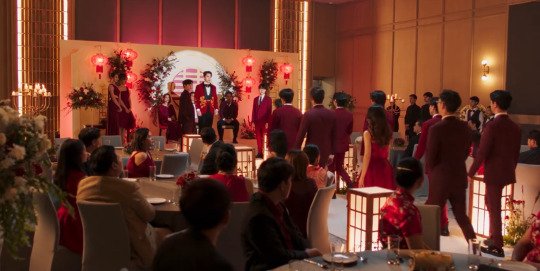
Then to have the gold dragons which represent Yi's family but are also Diao's color.
Y'ALL CAN'T TELL ME SHIT!
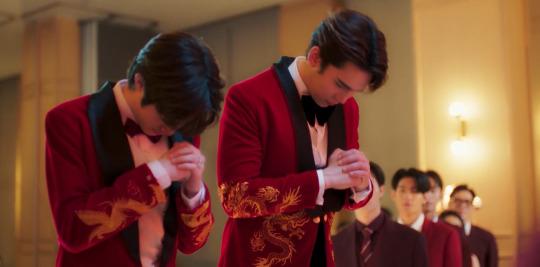
I'm in heaven. I do not care what the plot was. I do not care about the fake amnesia. I do not care about how the dog attack turned into a tiger attack. NO ME IMPORTA! Diao called out his father in front of all those rich ass people and God while wearing his man's color, and I'm living for it!
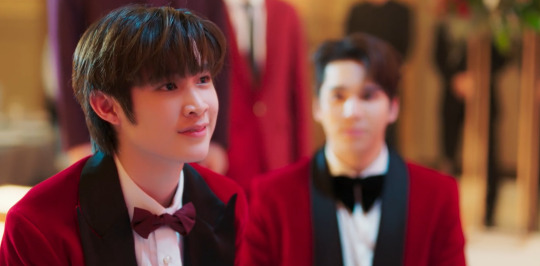
Kuea is a Red Rascal too, and I appreciated this public service announcement.

Diao sucked his thumb (😑), then they fucked, yet my color demon eyes only saw red candles. Thank you, props department!

Makorn asking if Diao wants a new husband (yes, sir. YOU!) while Yi wore red with that product placement red drink . . . *Mwah!* This blue table cloth gotta go though!
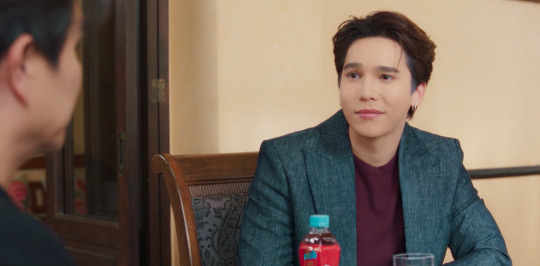
Red over Diao's heart, but that damn blue is still there! Diao, where is your yellow and orange, my man?! DONDE?! Oh yeah, they have kids with little rainbow toys. Good for them.

Hold on, was I supposed to remember this little girl? Diao was talking about her like I should know her. Who dafuq Le Ling?
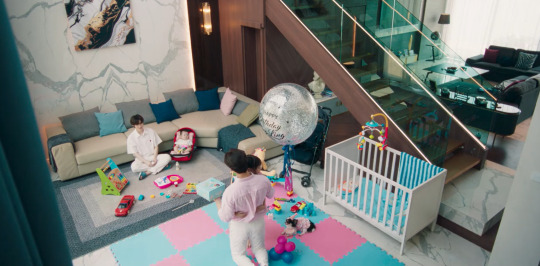
Even this baby was confused. Who is this chick? Girl, for reals, who is you?! This feels like Buffy the Vampire Slayer's fifth season when Dawn was introduced. Like I KNOW I ain't seen this chica before.

Well . . . she's part of the family now, so good for her.

All in all, YI IS A RED RASCAL, and marriage equality will come to Thailand no later than 2026.
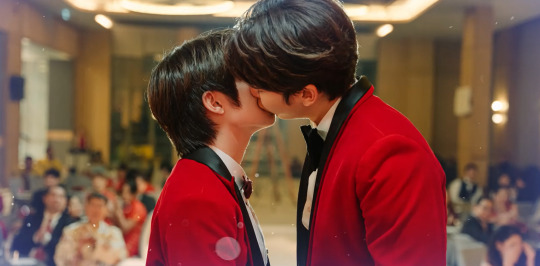
And same-sex partners will legally be able to adopt by 2029.
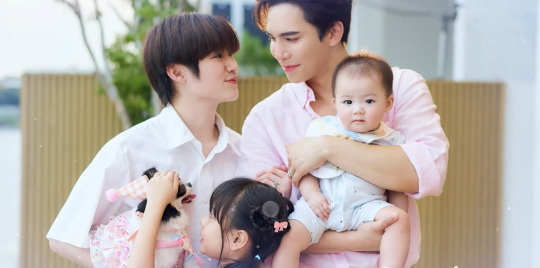
Naughty Babe, Cutie Pie, and Domundi said it with their full chest, and Apollo is gonna cosign it with his bouncy red ball because Red Rascals may not like each other, but they love to cause havoc when least expected, so . . . fuck it up, sis!

Amen.
#naughty babe the series#yi is a RED RASCAL#and Apollo is coming for Thailand#episode 8#I loved this show and I loved the finale#give me more please!#the colors mean things#color coded boys in love#the color exchange#marriage equality 2026?#apollo get on it!
62 notes
·
View notes
Text













So do you remember the royal consorts portraits going around royal simblr? Well inspired by @funkyllama, @warwickroyals, @thegrimalldis and @trentonsimblr I did my version of it but instead of it being just consorts this gallery also features some of Charleston's most notable rulers!
Have a calming drink cause it's a long post!
King Henri & Queen Astrid [ruled from 1382 to 1401]. Founders and the first King and Queen of Charleston.
King Erik ‘the Bloodfist’ & Queen Sigrid [ruled from 1435 to 1448]. Successful war leaders who united the warring Northern Tribes and conquered parts of Nord and Rionnag. They were also both spellcasters.
Queen Sofia [ruled from 1448 to 1549]. The first female ruler of Charleston and also the youngest monarch to ever rule. Changed the succession law to equal. Had 3 husbands during her reign. Was a spellcaster like her parents. She also currently has the longest reign.
Queen Märtha [ruled from 1562 to 1576]. Second wife of King Fredrik. She was a Nordian princess that married Fredrik for political reasons, but the couple ended up actually falling in love. During her reign she convinced Fredrik to return taken territories back to Rionnag and Nord and established Nord as a minority language.
Queen Henrietta [ruled from 1662 to 1677]. First consort with a university education. Established laws for women's equality as well as criminalized marriages for anyone under the age of 15. She was also an excellent spymaster.
Queen Sylvia [ruled from 1732 to 1753]. A known patron of arts she helped funding the construction of Charleston's Opera House. Took over the crown after the death of her husband, King Gustav III and reigned until her death.
Queen Victoria I & Prince Consort Harald. [Ruled from 1834 to 1870]. Victoria I wrote several laws protecting children's rights into action, including work laws and the age of equal consent. Harald was one of the founding members of the Nordic Alliance and served as a representative there during it's first 3 years.
Queen Inga & Sir Arthur Johnson [Ruled from 1887 to 1935]. Queen Inga is the only ruler to have used a veto for their marriage. She took the crown after the death of her first husband King Gustav VI; who famously ordered the Spellcaster Purge. Sir Arthur was the last active duty royal knight, and an important character in stabilizing the nation after the purge and it's resulted conflicts.
King Carl-Gustav IV & Queen Arianne (pictured here as Crown Prince and Princess) [Ruled from 1935 to 1960]. First royal couple to have their wedding televised. Both were well known children's rights advocates and build multiple safe homes for kids around the world. Queen Arianne also founded the Children's Royal Library, a charity organization focusing on giving books to children and raising literacy rates.
King Daniel [Ruled from 1992 to 2004] & Queen Marissa [Ruled from 2004 to 2026]. During his rule Daniel added a third gender option to law and hosted multiple LGBT+ charity events. His wife Marissa continued his work after his passing and was a very vocal supporter of her grandson Henrik's relationship with Michael.
Queen Victoria II & Prince Consort Benjamin [Ruled from 2026 - 2036]. Victoria II abolished the law preventing heirs from marrying foreigners in 2034. She also was an accomplished military general and diplomat. Benjamin was a human rights advocate and an exceptional diplomat who's efforts in the field gained him several medals of recognition, the highest being the Nordic Union Cross of diplomacy.
King Henrik & Prince Consort Michael [Ruled from 2036 - ]. First same sex ruling couple. Henrik legalized spellcasters and set them protection laws. He's also the first spellcaster ruler since The Spellcaster Purge. Michael is a former competitive swimmer and nowadays a patron of Charleston's national swimming team. He served in the military during the Charleston-Salix war and earned the "Heart of Lion" -medal of courage for his actions.
#that was a lot of people#and this isn't even everyone#why am I like this#the charleston royal family#ts4 royal family#ts4 monarchy#ts4 royalty#the sims royalty
30 notes
·
View notes
Note
Do you think Meg’s divorce narrative opportunity has slipped away? It seems like she is now really stuck in this relationship.
No, I don't think so, but it depends. I see it more as a wavelength, or pendulum, rather than a bell curve, so the opportunity is always there. It's just a matter of striking while the stakes are in your favor.
Here's a really simplified diagram to explain what I mean.

Meghan is only going to file for divorce when she's confident she'll win in the court of public opinion. So she needs the pendulum or the wave cresting in her favor. Some opportunities where she could have won divorce:
When Harry admitted that he was too embarrassed to ask for help with Meghan's mental health crisis (which happened in February 2019, and to which he admitted to in the Oprah interview).
When she miscarried because of media-induced stress.
When Harry published Spare and admitted to having significant anger issues, being a security risk because of his military work, substance abuse, and showed a predisposition towards airing private business. Meghan could have easily claimed she was scared for her and the children's safety (from Harry's anger, his security risk, and his drug use) and privacy (from Harry's big mouth).
But on the flip side of Meghan's pendulum is Harry's pendulum; all the times that it is swinging in his favor, in which Meghan would lose the divorce in the court of public opinion:
When she Megxited because of press/media harassment. Harry quit his job, left his family and friends, and moved out of his country for her. If she left him after that...
When Prince Philip and The Queen were dying.
When Charles announced his cancer diagnosis and Harry was playing dutiful son rushing to his bedside.
When I said yesterday that Harry and Meghan are on a fragile narrow ledge on their way to rock bottom, this is what I mean. We're at a moment where there's equal opportunity to be rescued (eg, a successful ARO product launch, half in/half out, fulltime royal privileges restored, a William and Kate reconciliation, etc.) or for the ledge to collapse (eg a failed ARO product launch, Charles dying, George and Charlotte being launched, the P.Diddy lawsuit/more revelations, the truth about the children's legitimacy, Invictus collapsing or firing Harry, etc.).
And while we don't know what's going to happen - i.e., to whom's side the pendulum is now swinging - we can assume fhat if the pendulum swings to Meghan's favor (like ARO has a successful product launch or the P.Diddy evidence against Harry becomes incriminating or Harry gets caught cheating) she gets a new divorce narrative and we could very well see her try; however, if the pendulum is going into Harry's favor (like they're getting royal privileges back or reconciliation with the Waleses), she's not leaving him.
But there was an anon - I don't remember where I saw the comment - that speculated Meghan is going to hang in there until they've been married 10 years because of the joint property/asset laws that kick in at the 10th anniversary. That sounds pretty plausible to me, but with two major caveats:
If Charles is still here. As long as Charles is King, there's a chance (however slight) that they could still go back to the royal family but that chance is gone in the single heartbeat that makes King William. And Meghan knows that. She knows that to squeeze every cent from Harry, she needs Charles alive because William isn't giving anything for her and Harry to fight over in the divorce.
The seven-year-itch is here, and the seven-year-itch is a very real thing. 2023 marked 7 years since they met and began dating. 2024 marks 7 years since they began living together. 2025 marks 7 years of marriage. They have to get through the seven-year-itch and if they make it to 2026, Meghan's going to hang on with every last fingernail to make it to June 2029.
38 notes
·
View notes
Text
Pride through the years
Book: Open Heart
Characters: F!MC Casey Valentine
Category: Fluff
Rating: PG
Warnings: mentions of homophobia
Word count: 901
Summary: A look through some of the key Pride Parades that Casey has been to.
Disclaimer: non OC characters belong to Pixelberry
Authors note: so this will be a similar format to my through the windows fic but Casey and Pride. This another submission for CWFC Pride Bingo Card. Pride Parade.
🏳️🌈🏳️🌈🏳️🌈🏳️🌈🏳️🌈🏳️🌈🏳️🌈🏳️🌈
June 2011.
Casey had been at NYU for a year now. She loved dorm life and had made good friends. This was her first major exposure to the lgbtqi+ community. She knew people who identified as such existed, she knew that those who identified suffered both systemic and non systemic abuse. To see the extent was an eye opener and not long before pride month she saw first hand some of the non systemic abuse. Her and a few friends were out for lunch, enjoying a gorgeous day in New York when her companions, who were only holding hands, were verbally abused and threatened. This experience was an eye opener for Casey and right then and there she decided she needed to be the change she wanted to see. A few weeks later there was pride and there was a March. It felt empowering attending, being with people who were open about who they were and who they loved and the fight that everyone had in them. Casey had only just decided that she was going to pursue medicine but she wanted to be the doctor that anyone who identified as lgbtqi would feel comfortable seeing.
June 2015.
It was the pride between undergrad and medical school and around campus there was an air of excitement. There had been a long time push for marriage equality and even though it was allowed in 36 states, all eyes were on SCOTUS to recognize it across all states. June 26th was a massive celebration but they knew there was a lot of work to do. She knew of the systemic abuse that still occurred and she was entering a health system that showed not the best outcomes for those who were lgbtqi+.
June 2019.
Casey was now a resident. She still considered herself an ally but work was busy, now that she was a junior fellow on the world famous Diagnostic team. She still attended events and she went with Jackie for most of them. Jackie had to hide it for most of her life, due to her parents and when she was away from home was still guarded about her sexuality due to her upbringing. Children were not on Casey’s radar yet, if ever but hearing Jackie’s experience made her determined to be the parent who would be understanding of her own child’s sexual orientation.
June 2022.
Casey was now an Attending and after the news broke that Roe was going to be repealed she was awed by Caroline’s proactivity. Casey knew that if women’s rights in health care were attacked, those who identified as lgbtqi were definitely going to be in the firing line. Caroline instigated a whole suite of measures and education aimed at the public and physicians so we knew where we stood legally, putting out education programs at community clinics in schools around women’s and sexual health and consent. Edenbrook fast became seen as an ally and Casey could not be any more proud of the organization she was working for.
June 2026.
There was more change at Edenbrook again but again there was much excitement. Caroline had not long announced her retirement from being the CEO of Edenbrook Hospital and her parting gift was a Medical centre that despite being apart of the hospital was going to be set in one of the more diverse areas of Boston both socially and economically and the primary focus was women’s health and the lgbtqi+ community. Casey was excited and hoped that at a local level in time there would be better health outcomes.
June 2034
Pride had become a family affair for the Ramsey’s. There was always plenty happening at the hospital but they always made an effort to go to a parade together. Hudson was nearly 9 and Alexis 5. Even though they were young both Ethan and Casey agreed it was good to educate them in an age appropriate way that the love that those who identified are people too, who love and are a part of society. This pride was bittersweet. Hudson enjoyed it but he was starting to not like being seen with his parents. Ethan and Casey did not want Hudson attending by himself just yet but they did not want one child missing out either. Ethan and Casey made the decision to continue coming to pride but leave the kids with family.
June 2047
Pride was special in more ways than one this year. It was first Pride for Alexis after coming out as bi-sexual and the first pride where Casey and Ethan were a parent to someone in that community. They were very proud of Alexis regardless, graduating top of her class and heading to UPenn but they were relieved when Alexis came out. She was less stressed and seemed to be really happy that she was a true version of herself.
June 2048
This was Alexis’s first pride out of home. She was loving college and had joined the lgbtqi club on campus. It was here that she was introduced to Polyamory and she enjoyed the freedom it allowed to explore her sexuality. Ethan and Casey were still very proud of her. Ethan and Casey were still very active at work and they had been noticing, at the local level any way even more and more better outcomes for those who identified as lgbtqi and both were really happy about that.
Tagging: @jerzwriter @jamespotterthefirst @genevievemd @liaromancewriter @potionsprefect @youlookappropriate @cariantha @bex-la-get @crazy-loca-blog @a-crepusculo @alj4890 @tessa-liam @binny1985 @schnitzelbutterfingers @lucy-268
@choicesficwriterscreations @openheartfanfics
#open heart#ethan ramsey#choices fanfic writers creations#casey valentine#choices#cfwc pride bingo#fic of the week#pride#choices stories we play
11 notes
·
View notes
Text
Teal Independents Spender and Steggall back census reform
New Post has been published on https://qnews.com.au/teal-independents-spender-and-steggall-back-census-reform/
Teal Independents Spender and Steggall back census reform

Teal Independents Allegra Spender and Zali Steggall have added their weight to calls by a raft of LGBTQIA+, health, and community organisations who are calling on the Albanese government to recognise all LGBTQIA+ Australians in the next census.
This would be achieved by including three new questions on sexual orientation, gender, and innate variations of sex characteristics in the 2026 survey.
A joint statement calling for the changes was released earlier this week by more than 90 organisations, including LGBTIQ Health Australia, Equality Australia, Mental Health Australia, SANE, and multiple Primary Health Networks.
The statement outlines how an “absence of relevant Census data for LGBTIQ+ populations means that health policy, programs and services cannot be accurately targeted, leading to increased healthcare costs and inefficient use of public resources”.
It goes on to say that “meaningful inclusion of these topics in the Census is essential” and calls on the government to “allow the Australian Bureau of Statistics (ABS) to do its job” and “support the necessity of including all three topic areas”.
Last week, Spender and Steggall wrote to the Prime Minister urging the government to reverse its decision to exclude the LGBTIQA+ community from the census.
The government has since announced a question on sexuality will be included, but not on other groups.
Recognising LGBTQIA+ people in the census was an election promise by the Australian Labor Party going into the last election and was reconfirmed by the party at its last national conference in 2023.
Allegra Spender’s electorate of Wentworth includes Oxford Street, Kings Cross, and has one of the largest LGBTQIA+ communities in the country.
“The census needs to recognise all LGBTIQA+ Australians, not just some,” Spender said.
The government’s u-turn last week was welcome, but trans and intersex people are still set to be left out. That’s not good enough.
You can’t make good policy with half-baked data. And we can’t recognise Australia’s incredible diversity if we leave some people out. Let’s listen to the experts and count everyone in.”
Zali Steggall represents the NSW seat of Warringa and was elected when Tony Abbott lost the seat, in part over his refusal to represent his electorate’s views on same-sex marriage, where 75 percent voted “yes” in the postal plebiscite.
“It is good to see the government has reconsidered its approach, but counting only some LGBTIQA+ Australians still falls short,” Steggall said.
“Including everyone in the Census is essential in shaping evidence-based public policy. Partial counts risk insufficient data and leave some in the community feeling overlooked or excluded.
“The richer, more inclusive the data, the better-informed policy can be.”
For the latest LGBTIQA+ Sister Girl and Brother Boy news, entertainment, community stories in Australia, visit qnews.com.au. Check out our latest magazines or find us on Facebook, Twitter, Instagram and YouTube.
0 notes
Text
The Importance of Griswold v. Connecticut
By Gemma Volpe-Monrean, Youngstown State University Class of 2026
November 28, 2023

Griswold v. Connecticut is the landmark case in which the Supreme Court ruled that states that banned the use of contraceptives violated people’s right to privacy. Connecticut law criminalized the use of birth control and any education that was provided on the use of contraceptives. In 1879 the law stated that any person who uses drugs or medical articles to prevent conception shall be fined not less than forty dollars and imprisoned not less than sixty days. In addition, any person who assists or counsels to commit such offenses may be prosecuted and punished. [1]
Griswold was the executive director of Planned Parenthood League of Connecticut and Doctor C. Lee Buxton was arrested and found guilty of accessory to providing illegal contraception. They educated a couple on family planning and the use of contraceptives to prevent pregnancy. They were fined 100 dollars each. They both appealed to the Supreme Court of Errors of Connecticut. They claimed that the law violated the U.S. Constitution. The Connecticut court upheld this deletion and they applied to the U.S. Supreme Court which reviewed the case in 1965. [1]
The Supreme Court made a 7-2 decision which was written by Justice William O. Douglas. The Court ruled that the law violated the supposed right to marital privacy and could not be enforced against married couples. Douglas stated that the Bill of Rights specifically guarantees emanations that give people help by opinion. The doctors in this solution gave their professional opinion when helping the couple in this case. In other words, the rights granted in the Amendments cannot be infringed upon. In addition, the right to privacy is fundamental when relating to married couples and their family planning. Subsequently, Connecticut must prove to the Court that its law is compelling and necessary to infringe upon that right. Connecticut failed to prove this, and the law was struck down. [1]
Other Justices agreed that marital privacy is fundamental, but they disagreed with Douglas as to where the fundamental right exists in the Constitution. Another Justice argued that the Ninth Amendment allows the court to find the final privacy without having to ground it in a specific Amendment. There were also claims that stated the fundamental right to marital privacy exists because marital privacy has traditionally been protected by American society. [1]
Currently, the use of contraceptives is protected under two major cases. Griswold v. Connecticut and Eisenstadt v. Baird are two cases that impacted the use of contraceptives. Both cases recognize the constitutional right to privacy and that it encompasses the right of married people to obtain contraceptives. Prior to these decisions, many states outlawed contraceptives along with prohibiting clinicians from prescribing or discussing contraceptive methods. After these decisions, many states still banned contraceptive use for single people. [2]
Eisenstadt v. Baird extended the right to privacy surrounding contraceptives to single people as well. The court determined that a Massachusetts law that prohibited birth control for unmarried people was unconstitutional. It was clarified that Griswold v. Connecticut was decided based on a marital right to privacy. A marriage consists of two people and each individual has a right to privacy and therefore a right to contraception. The court held that treating unmarried and married people differently violated the Equal Protection Clause of the 14th Amendment. Therefore, the Court explained the rights of an individual to have access to contraceptives must be the same for married and unmarried people. [3]
Furthermore, the Supreme Court made it clear that minors have a constitutional right to contraception as well. Restrictions on contraceptive access short of total prohibition are unconstitutional. The court struck down any provision that made it illegal to distribute contraceptives to a minor. The court explained that limiting the distribution of contraceptives imposes a significant burden on the right of individuals to use contraceptives if they choose to do so. They reaffirmed that minors have contractual rights and that those rights include the use of contraceptives. [3]
______________________________________________________________
[1] McBride, A. (2005). Expanding Civil Rights. Supreme Court History. https://www.thirteen.org/wnet/supremecourt/rights/landmark_griswold.html
[2] Felix, M., & Sobel, L. (2023, October 25). The right to contraception: State and federal actions, misinformation, and the courts. KFF. https://www.kff.org/womens-health-policy/issue-brief/the-right-to-contraception-state-and-federal-actions-misinformation-and-the-courts/#:~:text=Currently%2C%20the%20right%20to%20contraception,married%20people%20to%20obtain%20contraceptives.
[3] The right to contraception: Deeply rooted in our laws and society, but in jeopardy and in need of policymakers’ attention. National Women’s Law Center. (2023, June 26). https://nwlc.org/resource/the-right-to-contraception-deeply-rooted-in-our-laws-and-society-but-in-jeopardy-and-in-need-of-policymakers-attention/
0 notes
Text
As I was going through my rewatch of TDJ, something suddenly my mind. As far as we know, the series is set in a fictional, dystopian version of Korea. It is also set in near future, most likely 2026-27. But apart from a few things and the live trial court of course, this world seems to have more or less the same socio-economic aspects as our world does.
So what does that mean for acceptance of LGBTQ+ people? In this burned down, on-the-verge-of-anarchy Korea, are all Queer people and relationships looked down upon and berated still? Or is this a free world, where homosexuality is a norm and no one blinks an eyelid at what gender you or your partner is? Is this a world where gay people have to hide their identity for equal opportunities and safety or is it a place where there are popular gay celebrities and couples, gay marriages and no prejudice or discrimination on the basis of sexual orientation?
Most importantly though, if Homosexuality and Gay Marriage is legal in this Korea, was it Kang Yohan who pushed for and passed the verdict!?
#this randomly popped into my head#And now I can't stop thinking about it#I mean it makes perfect sense when you think about it#Kang Yohan could be openly bisexual but there is no concept of coming out in this world#So it isn't mentioned and because gay people are normal Lmao#I really need more details on the world building like GOSH#This is just some fodder for thought#Lemme know what you think though#anygays#the devil judge#lawful husbands#Lawless Husbands#kim gaon#kang yohan#Bisexual
35 notes
·
View notes
Photo



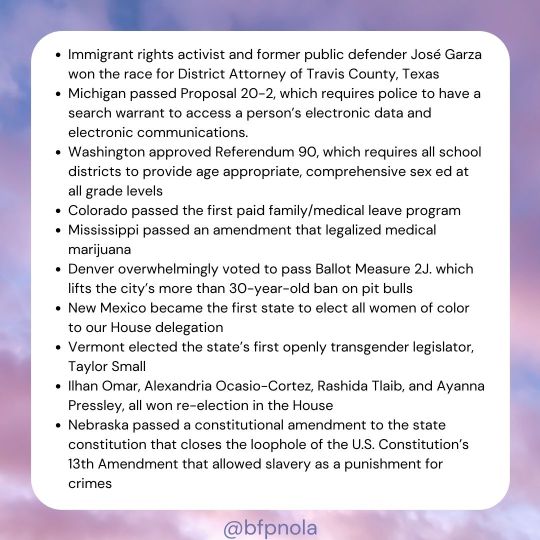
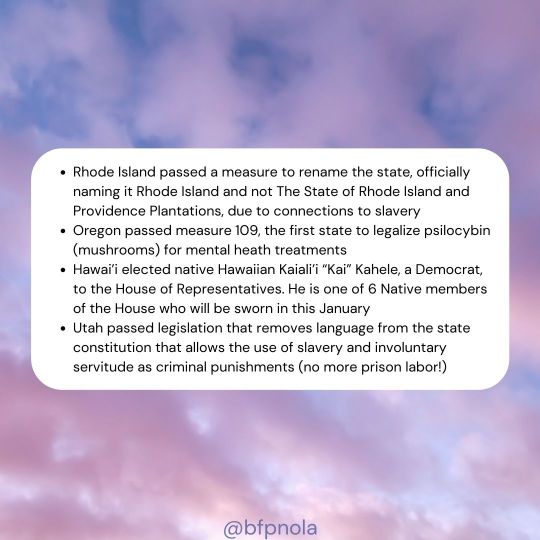
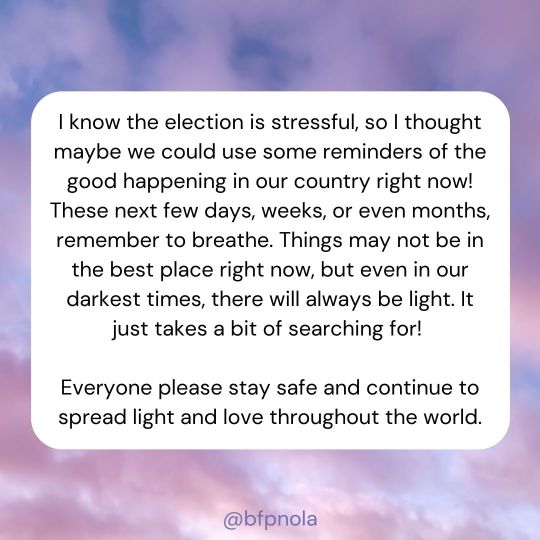
It’s BFP’s first original graphic! Please share, stay safe and spread light. | Compiled by @tayorswift
Click here for over 1,000 free social justice, mental health, and academic resources consistently updated throughout the year. Please share so everyone has equal and equitable access to education and activism!
[ID: the good news
Florida passed Amendment 2, which will raise minimum wage to $15/hour by 2026
South Dakota, Montana, Arizona and New Jersey all passed an amendment that legalized marijuana
Utah will now be removing gendered language in the Utah Constitution and will replace it with gender-neutral language
California passed Prop 17, which restores voting rights to previously imprisoned citizens
Delaware elected Sarah McBride, the first ever openly trans state senator
Ritchie Torres and Mondaire Jones are the first ever openly gay black members of congress
Cori Bush is the first ever woman of color to win a seat in Congress in Missouri
Mauree Turner became the first non-binary state lawmaker in America and the first Muslim member of the Oklahoma state house
Oregon has become the first state to decriminalize all drugs (small amounts of cocaine, heroin, methamphetamine and other drugs will have lesser punishments, similar to traffic tickets, and no jail time.)
Kim Jackson is the first out LGBTQ+ state senator in Georgia
Shevrin D. Jones is Florida’s first openly LGBTQ+ state senator
Jabari Brisport became New York’s first gay Black member of the house
Arizona flipped blue for the first time in 24 years
Michele Rayner-Goolsby became the first Black LGBTQ+ woman in the Florida Legislature
Voters in Colorado overwhelmingly rejected Prop 115, a state ballot measure that would have banned abortions after a fetus reaches 22 weeks gestational age. In rejecting the initiative, Colorado remains one of the most progressive states in the country on reproductive rights
Arizona will now send two Democrats to the Senate for the first time since 1951, thanks to the win of ex-astronaut Captain Mark Kelly.
Democrats have flipped the senate seat in Colorado, with the win of former Gov. John Hickenlooper
Mississippi is removing the confederate flag from their symbology
Marie Newman, who has been titled ‘a leader of the pro-choice movement’, will now represent Illinois’ 3rd Congressional District in Congress
Nevada became the first state to protect same-sex marriage in its constitution
Immigrant rights activist and former public defender José Garza won the race for District Attorney of Travis County, Texas
Michigan passed Proposal 20-2, which requires police to have a search warrant to access a person’s electronic data and electronic communications.
Washington approved Referendum 90, which requires all school districts to provide age appropriate, comprehensive sex ed at all grade levels
Colorado passed the first paid family/ medical leave program
Mississippi passed an amendment that legalized medical marijuana
Denver overwhelmingly voted to pass Ballot Measure 2J. which lifts the city’s more than 30-year-old ban on pit bulls
New Mexico became the first state to elect all women of color to our House delegation
Vermont elected the state’s first openly transgender legislator, Taylor Small
Ilhan Omar, Alexandria Ocasio-Cortez, Rashida Tlaib, and Ayanna Pressley, all won re-election in the House
Nebraska passed a constitutional amendment to the state constitution that closes the loophole of the U.S. Constitution’s 13th Amendment that allowed slavery as a punishment for crimes
Rhode Island passed a measure to rename the state, officially naming it Rhode Island and not The State of Rhode Island and Providence Plantations, due to connections to slavery
Oregon passed measure 109, the first state to legalize psilocybin (mushrooms) for mental heath treatments
Hawai’i elected native Hawaiian Kaiali’i “Kai” Kahele, a Democrat, to the House of Representatives. He is one of 6 Native members of the House who will be sworn in in January
Utah passed legislation that removes language from the state constitution that allows the use of slavery and involuntary servitude as criminal punishments (no more prison labor!)
I know the election is stressful, so I thought maybe we could use some reminders of the good happening in our country right now! These next few days, weeks, or even months, remember to breathe. Things may not be in the best place right now, but even in our darkest times, there will always be light. It just takes a bit of searching for! Everyone please stay safe and continue to spread light and love throughout the world.
End ID.]
#black liberation#black lives matter#blm#election#politics#republican#democrat#liberal#conservative#trump#biden#kamala harris#mike pence#headquarters -> new orleans#florida#south dakota#montana#arizona#new jersey#utah#california#delaware#lgbtq#lgbt#poc#bipoc#black women#rhode island#hawaii#pacific islander
57 notes
·
View notes
Text
Staunton and Sweet Briar College
Last week we drove up Lee-Jackson highway yet again on our way to Staunton. We were all eager to take a bit of a break from our usual Civil War related endeavors to see the Woodrow Wilson Presidential Library and House Museum. One of our good friends also got to come along for the adventure so that added extra fun to the day. The first thing we did was interview Andrew Phillips, the museum's head curator. He has done quite a lot for us two this year. Earlier in the school year, Tomi actually interviewed him for her virtual internship. All of us were excited to meet Andrew in person and talk about the direction of the museum.
Phillips has been at the Presidential Library since 2012. He came into the job without much knowledge of Wilson as he was a trained Civil War historian. Despite seeming like an unlikely candidate for the position, he was exactly what the organization needed. His extensive knowledge of the time when Wilson was in the home and of slavery is something the museum was lacking. Wilson was actually only at the Staunton home for sixteen months, so Phillips decided that it was time to use that to their advantage. His thoughts are that the museum needs to tell the whole story, from birth until the end of his life, with more of a focus on the events of the time he was alive. He did not mince words when he said that “...you will be disappointed when you go downstairs [in the museum].” The exhibits are over twenty years old and the museum has never undergone any renovations to change them. The exhibits are “very nitty gritty on Wilson” and Phillips wants to focus on the pivotal moments within his presidency. Phillips says that the events that happened while Wilson was president were “incredibly consequential” and wants to provide the context for visitors to understand this. By 2026 he and his team wish to overhaul the museum to be a space for education for the important moments that were hallmark to Wilson’s presidency. By expanding the exhibits, the staff can create more in-depth exhibits. Women’s Suffrage, World War I, the Jim Crow Era, and so much more will be covered in more detail than ever before in the museum. The staff at the museum has drive, passion, and ambition to complete these goals, but the only thing they are lacking are the funds. They have applied for multiple grants, but have not received what they need. If you would like to learn more about how to become a member or to help out Phillips and his cause, click here: https://www.woodrowwilson.org/ways-to-give .
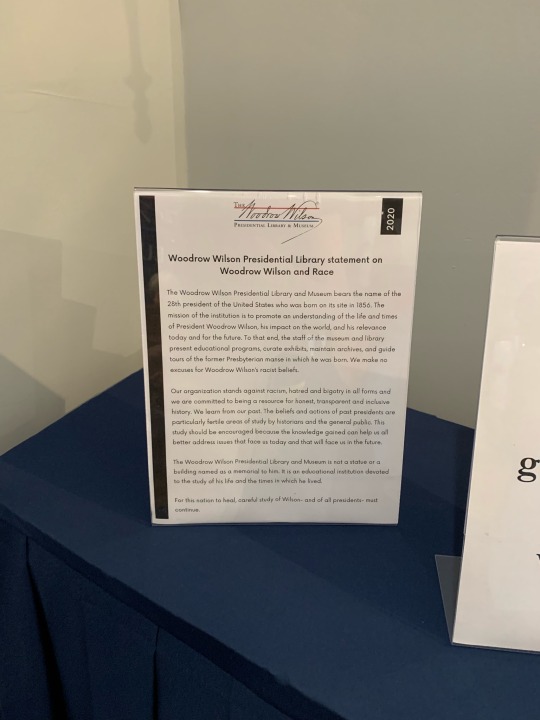
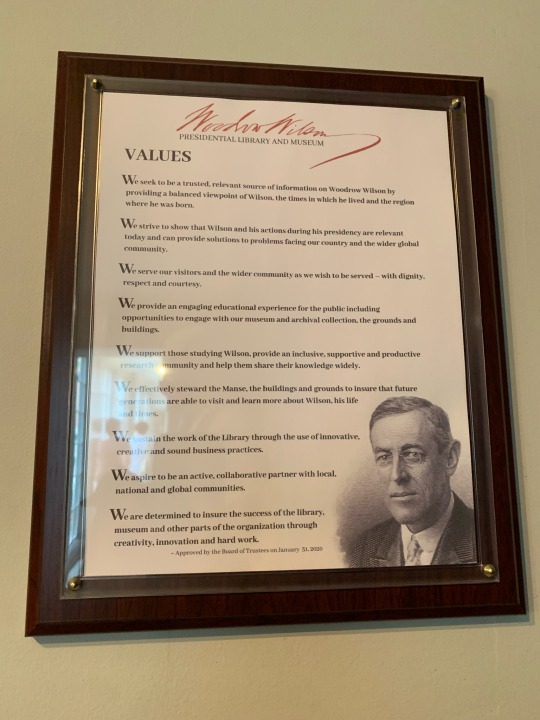
Even though the big steps have yet to be taken, Phillips has already had to make major changes. “When I first got here, in 2012, they were still calling the enslaved people servants. They were misinformed and I had to change that,” he said, speaking of tour guides and how they addressed the enslaved population of Wilson’s first childhood home. The guides were trained initially to use the term “slave” and then later “enslaved person” by Andrew. Phillips said that he and his staff spent at least one year changing this narrative. “The guides wanted to learn and were more than open to the change, but these kinds of things take time.” His next steps are attempting to learn the names of the three leased enslaved people from the church Wilson’s father preached at. “I want to give these people names. We know what they did for the family, but I want to give them their names.” After the tumultuous summer of 2020, he could not stand for the poor exhibit on African Americans to continue to stay up. Phillips claimed that it was “too neutral” and was “sensitive to a position that Civil Rights is bad and showed two sides of the coin.” He and his staff took a huge leap in creating all new signage to create a more honest narrative about how African Americans were treated by the Wilson administration and the country. “We are constantly trying to improve,” said Andrew and we could not agree more. Speaking with Andrew about all the changes that have taken place and that will soon take place was so inspirational. We cannot wait to come back one day to see how much the museum is transformed!
The Woodrow Wilson Museum is an older institution that presents the life and legacy of the man that led the United States during one of the most challenging periods in world history. We first encountered an exhibit that follows Wilson before he became the 28th president. He earned his Ph.D. in political science from Johns Hopkins University before becoming the president of Princeton University, where he incorporated many progressive reforms. He was also governor of New Jersey between 1911 and 1913. We were able to see some reproduced and original artifacts that belonged to Wilson. We were also able to read about his two marriages. He only married Edith Bolling in 1915 after Ellen Axson died in 1914 while he was in office. In the first few rooms, we saw how he campaigned against Republican presidential incumbent, William Howard Taft, and third party candidate, Theodore Roosevelt. As we learned in our interview with Andrew, the museum is no longer misguiding visitors about the actions taken by President Wilson. Though he enacted major reforms like the Revenue Act of 1913 and the Federal Reserve Act, he also allowed segregation to continue within the federal government and throughout the entire country. We saw the newly added yellow Civil Rights panel that did not shy away from being completely frank about Wilson’s personal views. He was a racist man, but again, we saw some pretty consequential things come out of his time in office, such as the passage of the 19th Amendment, which finally gave women the right to vote in elections across the country. This Amendment was only possible after the lobbying of famous suffragists like Lucy Burns, Carrie-Chapman Chatt, as well as the many others that came before them. Though the United States remained neutral through much of the Great War (World War I), we were able to see why and how Wilson convinced Congress to declare war on the Central powers in Europe. The exhibit in the basement about the war was our favorite part of the museum. As the museum mentioned, Wilson was a master negotiator in setting up the Treaty of Versailles and the League of Nations, but the U.S. Congress did not ratify it as Wilson refused a Republican compromise. It was the terms of the Treaty of Versailles that led to the rise of Adolf Hitler in Germany, and the world would yet again enter a deadly conflict only a little more than a decade later. Woodrow Wilson was anything but a decent person that sought equality for all, but we must study his life and presidency at places like the museum and library in Staunton. If we want our country to be better for all Americans, then we must remember and learn from the mistakes of our former leaders. The history within truly matters and we are looking forward to newer interpretation once the anticipated renovations are completed. If you are able, we highly recommend a visit not simply to say you went to a presidential site, but to learn from Wilson’s successes and errors.

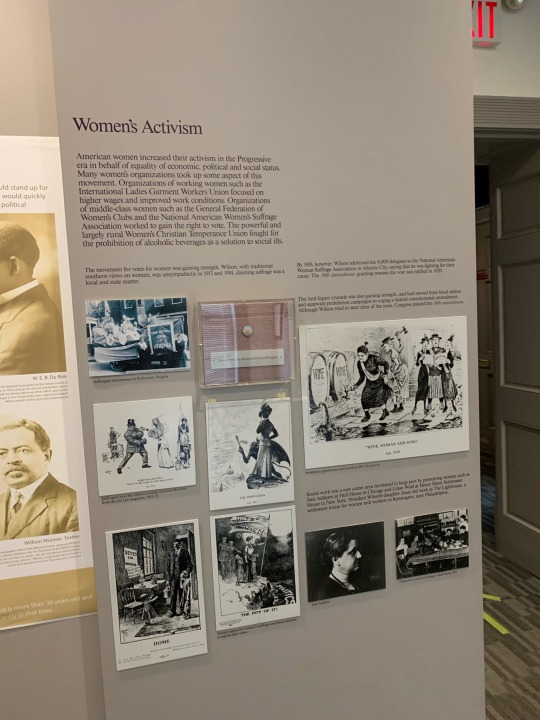
After we walked through much of the museum, we went on a tour of the home where Woodrow Wilson spent the first few months of his life. Joseph Ruggles Wilson and Janet Woodrow started their family in the house known as the Manse in Staunton. The family owned and defended slavery through the end of the Civil War, and Joseph was a Presbyterian minister and chaplain for the Confederacy. Though not much is known about the enslaved persons that worked at the Manse, it does seem that an effort is being made to present what they did in the house while enslaved by the Wilsons. A question was posed by another visitor that was on the tour with us. “What is the difference between saying enslaved person and slave?” The tour guide responded that this was the phrasing that most Virginia museums are using. While this may be true, there is more to it than that. Dr. Sherayko stepped in to offer the whole reasoning behind this choice in language as heard at Monticello and Appomattox. Saying “slave suggests an identity of subservience to others and nothing else. Stating “enslaved person” instead suggests an identity of personhood first, not just the condition they had forced upon them. It is important to understand this shift in language as the stories and personhood of those that were enslaved matter too. We hope that when asked similar questions in the future, the tour guide responds with this explanation. Overall, the house tour was a quality look into a historic home and showed how the Wilson family lived.
On our way back from Staunton, we made a pit stop at Sweet Briar College. The 3,250 acre campus is in the heart of Amherst with beautiful mountain views. We drove all the way back to where their top notch equestrian team practices to see Monument Hill. It is a small cemetery to the founders of the college’s daughter that has expanded to include members of their family and faculty who have passed on. Looking out from this point is an absolutely stunning view of the campus. The tall angel statue for Daisy Williams, founder Indiana Fletcher's daughter, stands tall overlooking the campus as a guardian. We drove around the campus after viewing this solemn, serene area and came across a small cabin in the backyard of the president's home. It is the only surviving slave cabin on the property. What once was the home to enslaved people of the William’s plantation has been used as office spaces, storage, and other uses by the college. But in 2012, with the help of the Virginia Foundation for the Humanities and Lynn Rainville, the cabin was re-interpreted to capture the history of the 170 year old structure. There were signs telling the history with old photographs, maps, and even the names of those who lived in the cabins. The most important piece of signage was the recognition of descendants of those who once lived, worked, and who are buried there today. It was a small, yet powerful exhibit that is worth the visit.

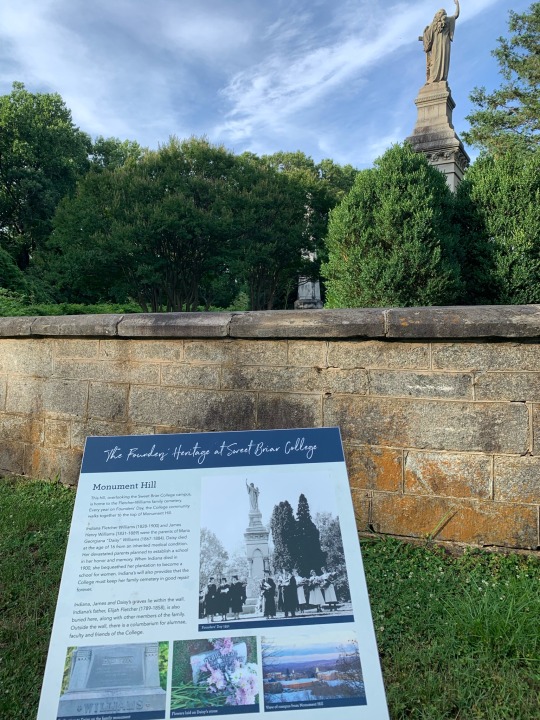
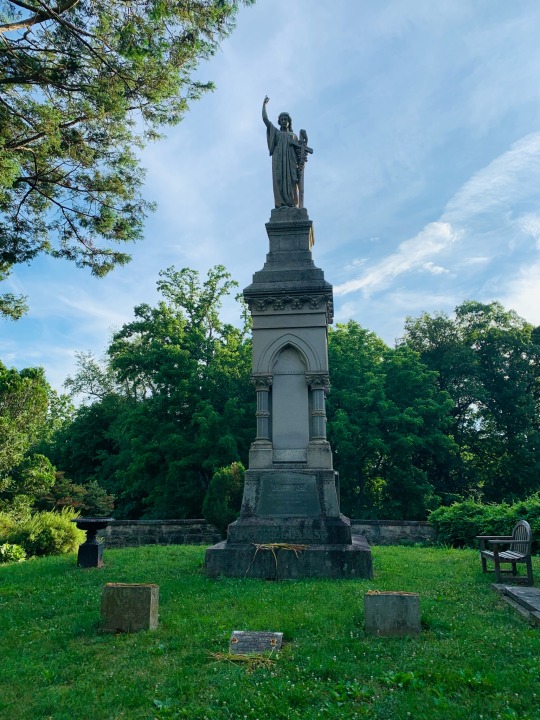
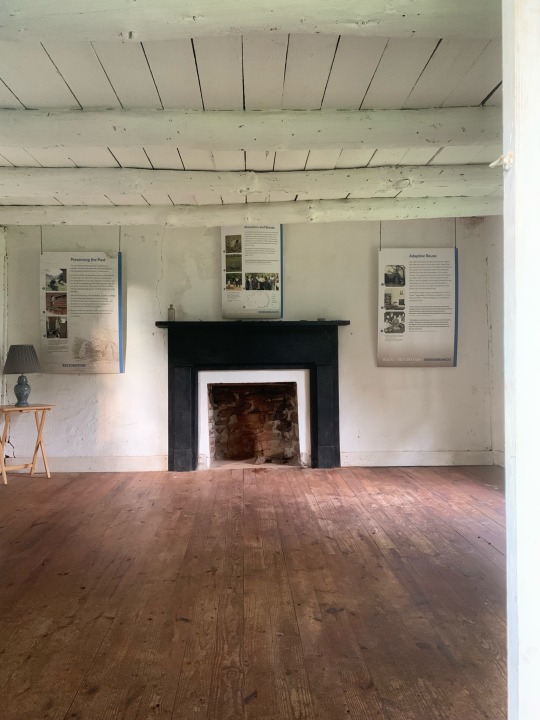
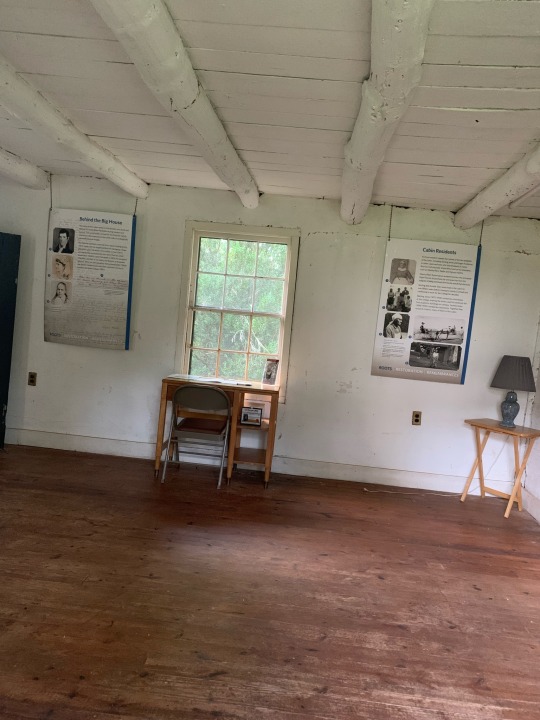

1 note
·
View note
Text
2020s: A decade of immense change
What will the 2020s hold? From the possible discovery of alien life forms to the rise of lab-grown meat, the new 20s may very well be quite an eventful decade. If the past decade is any measure, it will be one of innovation, rapid social and technological change and one of scientific breakthroughs that will alter our perspectives of life, the Earth and the universe at large. However, in what ways will the 2020s differentiate from the 2010s in terms of where most change will occur and more importantly what will these changes be? I’ll break up potential areas that the 2020s may be someday known for in to the groups of science & technology, politics & society and events (to take in to consideration those which may not fit in to the either of the first two categories).
Science & Technology:
Will the 2020s be the decade when we discover alien life? From the discovery of frozen water on the Moon and Mars to evidence of organic material on Enceledaus, there are more and more hints of the potential existence of alien life forms in our own back yard. There seems quite a reasonable chance that by 2030 we will have discovered at the very least microbial life forms somewhere in the Solar System. With missions planned for the not so distant future such as a proposed mission from NASA to land an underwater probe which will make its way beneath the ice sheets of Europa and explore its likely ocean beneath for life and more missions planned to land on the surface of Mars in the coming years, the potential for such a breakthrough will only continue to grow. Of course, there is also the possible scenario where we make contact with an alien civilization although for now that remains an impossible subject to gauge in terms of when such contact will be made, if it is to be made; so that remains a possibility.
While we may not make contact with an advanced alien civilization in the 2020s, we may make ‘contact’ with an advanced form of artificial intelligence in the 2020s or at the very least begin to find ourselves closer to creating such AI. Futurist and inventor Ray Kurzweill who made many successful predictions including foreseeing the fall of the Soviet Union has long stated that 2029 will be the year in which the ‘technological singularity’ (when general machine intelligence surpasses that of a human being) will take place. Even if AI does not reach this level of intelligence, the use of AI in various fields of work alongside automation in general poses major potential and risks for the future of humanity. There are growing concerns that automation is about to create mass unemployment and indeed the signs of this are beginning to emerge as more and more jobs are being automated. The world is of course completely unprepared for this and the potential impact such a scenario could have on a world already deeply polarized and engaging in radical politics is in many ways frightening. I’ll discuss this more in the ‘events’ category.
What about autonomous and clean energy vehicles? Of course it’s been a bit of a rocky road at times for both technologies and neither has yet to really take off but the potential for their rapid growth is there. It may take time but it seems quite reasonable that as the decade progresses autonomous and clean energy vehicles and autonomous clean energy vehicles in a unified form will begin to really enter the mainstream. If effects on civilization from climate change is to truly take off in the 2020s, it may heavily incentivize a change in the direction of clean energy vehicles and of course renewable energy across the board. Although there is no doubt that the rise of renewable energy will be a long process but if price parity between energy such as solar can be reached with fossil fuels then the possibility of a rapid switch over is feasible although special interests and their influence over the political sphere.
Politics & Society:
What about politics? This one will likely be particularly dramatic. The United States under Trump poses drama at least until January 2021 and possibly January 2025. Should Trump be re-elected then his turbulent presidency will remain the centre of global focus for the first half of the decade. Should someone else be elected then the 2020s will be remembered in a very different way in terms of United States politics. What about populism? It seems unlikely to go away any time soon and if we see the mass unemployment some prophesize when it comes to automation then this may escalate current trends and this could be quite dangerous. Mass unemployment, economic turmoil and the likely continuation and escalation of income inequality could create the conditions for quite a dangerous time for western democracy. However, on the contrary it may in many nations create an opportunity for a brand new world. Universal Basic Income is an idea considered as a solution to the rise of automation in the work force. Some populists and eventually regular politicians (even if out of political necessity) may push for UBI and slowly this could help reduce income inequality and reverse some of the uglier economic trends seen in this century thus far –ushering in a post-neo-liberal era in global economics – possibly. The legalization of marriage equality and Marijuana are likely to remain trends throughout the 2020s and may spread to new corners of the globe. What about the ‘democratic recession’. Will it continue or will it some to a halt and maybe even reverse by the end of the decade? This may all depend on how the world deals with a changing economic, political and technological arena. Will we also witness a cooling off of tensions by the end of the 2020s? Will the internet be as heated and angry as a place or will it be ‘more chill’ by 2030? These are questions worth considering but it’s too early to give any realistic answers. Clean meat, veganism and animal rights are also likely to enter a new phase during this decade and we can expect to hear a lot about clean meat in the 2020s as a potential means to ending factory farming in the future.
Events:
What about the next downturn? Growing income inequality + mass unemployment from automation has the potential to make the next downturn worse than the last which again is quite a frightening thought when we consider how polarized and turbulent politics and society has become throughout much of the world. Of course a serious global recession (possible global depression) has the potential to act as a major event and crisis in of itself which would impact all of us. What about climate change? It may very well be that during the 2020s the effects of climate change begin to really take off and climate denial may begin to disappear from the political mainstream. The likes of the Republican Party in the US may no longer be able to get away with denying scientific facts by the time this decade is out. What unexpected events may we witness? Will bioterrorism or even worse a major global pandemic become a reality in the 2020s? And what is the future of cyberwarfare? Perhaps it may only develop more rapidly and become a more significant aspect of global political affairs. An AI arms race is also a possible scenario. How about wars? Will the United States and Iran go to war? What about Israel and Iran? What nations may descend in to civil war? How about Zimbabwe, North Korea, Venezuela, Greece and Turkey? And will climate change destabilize nations which are currently relatively stable, leading to pre-war conditions? After all Syria was in a stable state not so many years ago before descending in to a devastating civil war. Only time will tell of course as these events are largely unpredictable. However the sort of events we can predict are Tokyo hosting the 2020 Summer Olympics, opening the decade to its first major sporting event unless of course you classify the multi-nation hosted Euro 2020 as a major tournament which will occur a couple of months prior. Qatar will controversially host the 2022 world cup before Paris hosts the Olympic Games in 2024, Canada, Mexico and the United States will then co-host the World Cup in 2026 before Los Angeles hosts the Summer Olympics in 2028. It seems feasible that the Summer Olympics will see a decline in viewership during this decade and while the world cup may face many boycotts in 2022, at the least 2026 is likely to be a very popular event and likely the most popular sporting event of the 2020s.
Conclusion:
In conclusion, we can expect the 2020s to be a time wherein major social and technological upheaval will take place. A shift to a post-neo-liberal, perhaps more China-oriented economic framework in a more settled yet altered global political culture is all quite possible while AI, clean meat and renewable energies may push us to the precipice of revolutionary changes in how we use technology, where people’s food comes from and how we provide energy for ourselves as a civilization. We will also see millennials transcend a time in which they were the subject of constant criticism by older generations to moving closer and in some cases becoming the ones in charge while Gen Z will make up more of the work force and by the end of the 2020s, Facebook will be 25 years old.
0 notes
Text
Victoria Beckham Says She’s ‘Trying to Be the Best Wife’ Following David Beckham Divorce Rumors
Victoria Beckham continues to shoot down divorce rumors.
The 44-year-old fashion designer opened up about her marriage to David Beckham at the Forbes Women's Summit in New York City on Tuesday.
"I try really, really hard. I try hardest to be the best mother. I am trying to be the best wife and the best professional," she said, according to Hello! "When I get home I try to put the phone down and spend time with the children and spend time with David."
Though Victoria admitted that she's "been known to hide in the bathroom at weekends just to send a little email," she praised her husband for how he handles things when she's away.
"I have the support of an incredible husband," the former Spice Girl said. "We really are equal with everything we do at home with the children. When I'm away he's the one doing the school run and doing the cooking."
Murmurings of a possible divorce began earlier this month, but a rep for Victoria quickly denied the speculation.
"[Victoria and David are] not divorcing or splitting, and reports to the contrary are false," the rep told ET of the couple of nearly 19 years.
A rep for the couple concurred saying, "It is absolutely not true."
Since the statement was made, the pair has been seen out and about together. On June 10, they attended the Kent and Curwen fashion show at London Fashion Week. Victoria even posted a sweet snap of her husband's hand on her shoulder.
#momentcaptured ❤ 📷 @katrinaisrael
A post shared by Victoria Beckham (@victoriabeckham) on Jun 10, 2018 at 8:02am PDT
Last week, the parents of four joined friends and family at dinner to celebrate the successful efforts of the U.S., Mexico and Canada in their bids for the 2026 World Cup.
Amazing night ... All about families and memories .... Miami all the way... celebrating USA , Mexico & Canada getting the 2026 World Cup @futbolmiamimls we miss you @marceloclaure
A post shared by David Beckham (@davidbeckham) on Jun 13, 2018 at 3:24pm PDT
"All about families and memories," David, 43, captioned an Instagram post in part.
Here's more on the couple's relationship:
RELATED CONTENT:
David and Victoria Beckham Enjoy Celebratory Family Dinner With Their Sons
Victoria Beckham Steps Out With Husband David After Shutting Down Split Rumors: Pics
David and Victoria Beckham Address 'False' Divorce Rumors
#_revsp:new_provider_with_logo_342#_lmsid:a0VK0000001yfWcMAI#_uuid:fddf0826-6c3b-3069-b8de-00707edfebbb
0 notes
Text
‘Feminist’ Canada has workplace gender gap worth $150 bn, adds report
Despite Justin Trudeaus efforts to stress his countrys female-friendly credentials, a new report has identified a significant gender chink in its workplaces. Is Canadas feminist persona very good to be true?
Canadas prime minister is a self-proclaimed feminist. Two years ago, Justin Trudeaus appointment of the countrys first gender-equal cabinet stirred headlines worldwide. Lately, his government has liberated what the fuck is been called the firstly feminist foreign aid programme.
But now Canadas own enter on gender equality has been called into question by a perhaps unlikely root. The McKinsey Global Institute, studies and research limb of the corporate consultancy monster, has declared that the countrys workplaces have a substantial gender gap.
In a 124-page report, it describes attacking tolerating gender inequalities at work as a significant financial the possibilities for Canada, which it predicts could add upwards of $150 bn to the countrys GDP by 2026. McKinseys Tiffany Vogel told CBC that gender equality is not just a moral imperative[ and] not only the right thing to do its good business practice.
Recent data from Canadas national statistics busines shows that for every$ 1 a serviceman prepares, on average a woman builds $0.74 in part because women are disproportionately represented in low-wage places, including in fast food and hotel work.
A study of Ontario retail proletarians most of whom are women found that people pay more across all job categories, and are more likely to be offered full-time responsibilities or hired as directors.
The gender issue imbues all levels of business: corporate committees are dominated by humankinds, and 95% of CEOs are male. McKinsey surveyed 69 of Canadas largest corporations and found that fewer women were being promoted. Among these companies, wives make up 45% of entry-level laborers, 25% of vice-presidents and 15% of CEOs.
The gender pay gap persists in all types of occupations, even when women are in higher-paying undertakings, articulated Trish Hennessy, a director at the Canadian Centre for Policy Alternatives( CCPA) thinktank. Pay gaps are particularly enunciated for migrants and indigenous girls, she added.
Hennessy said one way to close these breaches is to revalue the caring operate that women do referring to payable work at home, attending for own family members, and paid work including in early childhood education. Unionisation facilitates, more, she said. The gender pay gap is lower in unionised responsibilities solidarities can be a great equaliser.
Last time, Canada also fell down in the World Economic Forums world equal opportunities rankings, to 35 th region. In 1995, it was in first place.
Canadas foreign minister Chrystia Freeland, right, in Berlin: Justin Trudeaus government boasts the first feminist foreign aid plan. Picture: Markus Schreiber/ AP
Armine Yalnizyan, a Canadian economist and business commentator, said that while gender inequality at work is a national difficulty, there are huge differences across the country. For instance, she said the Saskatchewan province shows more equal than neighbouring Alberta, which has bigger offer chinks.
These cracks are falling among young people, she alleged, but theyre nowhere near shut. Its people that dont have more than high-school[ education] that view the biggest compensation gap between women and men.
Yalnizyan said higher minimum wages would affect practice more females than beings, and would begin to compress wages. She also described increasing access to childcare and early childhood education as a virtuous circle, enabling more girls to act while also creating jobs.
The McKinsey report speaks deal with the gender inequalities could lead to re-energising Canadas economy and its transactions. It reads GDP growth has slowed to nearly 2 % a year, and that a significant part of the answer is for Canada to tap into the vast, unrealised potential of women.
The revolution is unfinished
Gender inequality at work is not a uniquely Canadian trouble. In the US, women make less than $0.80 for every$ 1 that people do. In the UK, the gender pay gap is around 18%.
Globally, guesses suggest that exactly 24% of senior management characters are filled by ladies. In more than 120 countries, a potential bos can legally ask about the status of women children or marriage status at a job interview while in more than a dozen states, partners can prevent their spouses from consenting errands.
It has become something of a zeitgeist polemic to describe gender equality as good for business. Last time, a UBS report alleged it is in fellowships interests to promote girls up their grades, and that attacking the inequalities could add 10 tn to the global economy.
The Economist has engraved narratives with headlines such as Girl power gender equality is good for financial growing. Women administrations have called for others to lean in, and there have been campaigns for more women in boardrooms and MBA programmes.
In Canada, McKinseys report insists, more females need to get into managerial capacities, high-productivity sectors such as petroleum, mining and technological sciences, or become entrepreneurs. Firms need to do more to promote women through the corporate pipeline.
National statistics mention 82% of women aged 25 -5 4 were working, or looking for a job, in 2015 is comparable to 21% in 1950, and 63% in 1983. Canadian girls university graduates outnumber boys with these stages yet girls are overrepresented in lower-paid jobs and are more likely to work part-time, juggling payable child care and other responsibilities at home.
Hennessy said that Canadian dames are more educated than ever, and are already contributing to financial rise but as long as the gender pay gap perseveres, the revolution continues unfinished.
She lent: Pay troubles, but so do working conditions. Many occupations that dames work in are precarious: hours are part-time or casual, they dont have welfares or pensions. That means the gender pay gap follows them all the way to retirement.
Canada also has a broader economic difference problem. In January, an Oxfam report found that two of the countrys billionaires are as wealthy as the most impoverished one-third of its own population.
Lauren Ravon, programme director at Oxfam Canada, said the situation of low-income girls has been a blind spot in discussions about gender inequality at work, which tend to focus on entrepreneurship, leadership, corporate committees and senior executives. The reality, she added, is that much economic opportunity for women is in the lowest-paid jobs.
We need to have a society where we value the design that girls have traditionally done: education, childcare, healthcare, Ravon pronounced. She expects a huge increase in home-based care in the future, as Canadas person ages.
The Trudeau government recently announced it would play gender-based analysis of its budgetary evaluates, in order to deliver real and meaningful change for all Canadians. It has also promised to bring in national repay equity legislation, although it was has been criticised for delaying this until 2018.
At the CCPA thinktank, Hennessy answered: Why not take inspiration from Iceland, which has committed to a plan to wholly close the gender pay gap in 5 years season? Set a aim. Determine a timeline. Run the schedule and make it happen.
If she wished to share your experience of workplace inequality, wherever you live and production, email us in confidence at inequality.project @theguardian. com
The post ‘Feminist’ Canada has workplace gender gap worth $150 bn, adds report appeared first on vitalmindandbody.com.
from WordPress http://ift.tt/2eXU2ht
via IFTTT
0 notes
Text
A Gem On The Mediterranean – 10 Things To See And Do While Attending The INTA Annual Meeting In Barcelona
Barcelona may be my favorite city in the world. It is certainly a top contender. Because one of my dearest friends is a native Barcelonian, I’ve been fortunate enough to have visited multiple times, and I have also had one of the best tour guides you could hope for. So when I found out that the 2017 International Trademark Association (INTA) Annual Meeting (May 20 -24) was being held in BCN (a common abbreviation for the city and its airport), I had only one question – Where do I sign up?
See this post in Spanish.
A Bit About the City
Barcelona, the capital city of the autonomous community of Catalonia, is nestled on the Mediterranean on the northeast coast of Spain. An ancient city (one unverifiable legend suggest that Barcelona was founded by Hannibal’s father, Hamilcar Barca, and eponymously named Barcino in the 3rd Century BC), Barcelona was an important center of commerce for the Roman Empire by the 3rd Century AD. It fell to the Visigoths in the 5th Century, came under Moorish control in the 8th Century, was taken by the son of Charlemagne in the early 9th Century, came under the Crown of Aragon in the 12th Century, and then came under the rule of the Spanish monarchy with the marriage of Ferdinand II of Aragon and Isabella I of Castile in 1469. In the 20th Century, as home to Pablo Picasso, Joan Miró, and Antoni Gaudí, the ancient city became a wellspring of all things Modern.
Given its storied history, Barcelona teems with architectural, artistic, and cultural wonders, and offers cuisine and gastronomy that is virtually unparalleled. If you’re going to be there for the Annual Meeting, I definitely recommend removing your “I am at a conference” blinders so that you can take a good look around. Need some help? Here are ten things that I would recommend checking out. And remember, this list could be ten times longer, so try to save some time for exploration – you won’t be sorry.
Look Up!
The architecture in Barcelona is almost unbelievable. Gaudí is a main reason why. This Modern architect and designer, heavily influenced by the Gothic Revival, transformed the look and feel of the city. Structures like Casa Milà, also referred to as La Pedrera (“the quarry”), give Barcelona an other-worldly aura. But that’s not all – you can take a stroll around Barcelona’s ancient Roman walls, visit the Gothic-era Barcelona Cathedral, behold the unlikely eminence of the colorful-by-night Torre Agbar, or bask in the Modern splendor of the Palau de la Música Catalana (The Music Palace of Catalonia).
There is all this and so much more. No matter your taste, there are sure to be at least a few buildings in Barcelona that you will adore.
Tuck In!
Get ready to eat. Is fine dining your thing? If so, you are in luck! Barcelona has long been a hotbed of gastronomic excellence and innovation. As head chef of the (sadly) shuttered, but still legendary El Bulli restaurant, Ferran Adrià put Barcelona on the international culinary map when he rose to the role of head chef in the 1980s. Molecular gastronomy took hold, and Barcelona didn’t look back. Mr. Adrià’s younger brother Albert, who was the pastry chef at El Bulli, has since put on a new apron and proved himself to be his brother’s equal in crafting savory fare. His Tickets and Bodega 1900 restaurants are considered among the best in the world. Jordi Cruz, who at the age of 26 was the second youngest chef ever to be awarded a Michelin star, now serves his creative cuisine at ABaC Restaurant and Hotel.
If trendy isn’t your cup of tea, there’s no need to worry. Barcelona overflows with wine bars, tapas and pintxos places, traditional Spanish restaurants, and seafood for days. This is just the tip of the iceberg. Bring your appetite, because you’re going to need it.
Check out a Museum
Is art your thing? Barcelona’s got it. The Picasso Museum features some of the artist’s Modern masterpieces, like selections from the Las Meninas series, but it also features many of his early, pre-Cubist works, which sheds some light on Picasso’s evolution as an artist. The National Museum of Catalonia has a wide ranging collection of works from Roman times to contemporary art. The Joan Miró Foundation is a personal favorite. I have a great appreciation for Miró, and a print purchased at the museum hangs in my office.
Take a Stroll in the Parc
Park Güell (or “Parc” in the native Catalan language), is a series of public parks and architectural elements located in Barcelona on Carmel Hill. It is stunning. Originally conceived by Spanish entrepreneur Eusebi Güell as a residential enclave for the wealthy, Güell entrusted the task of designing the compound to Gaudi, his lifelong friend. Reportedly, Güell once said to Gaudí, “I don’t like your architecture, I respect it.” This is a sentiment I don’t share, but I don’t think Güell stood alone in that thought. In any event, the park never became a commercial success. Only two houses were ever built on the property, including the one Güell died in. In 1923, the Güell family gifted the park to the city of Barcelona.
Visit a Church that Has Been Under Construction for 135 Years
The Basílica i Temple Expiatori de la Sagrada Família (“Basilica and Expiatory Church of the Holy Family”), commonly referred to as the Sagrada Familia, is large Roman Catholic church designed by Gaudí. (Are you sensing a theme?) It is his as yet incomplete magnum opus. Construction of the structure commenced in 1882, and has continued fairly constantly (there was an interruption due to the Spanish civil war) until this day. The sixth and final construction phase started in 2010 and current projections call for completion in 2026, which will mark 100 years since Gaudí’s death. La Sagrada Familia is also the architect’s final resting place. This masterful combination of Gothic and Art Nouveau styles is open daily from 9 am to 8 pm at this time of year. There is an area for worship and contemplation within the basilica, but regular masses are not currently being held.
Set Aside Some Time for Marketing
The modern supermarket is a fact of life throughout much of the world, and Barcelona is no exception. But BCN’s network of neighborhood food markets still plays a vital role in the life of the city. Need fresh fruits and vegetable, meats or fish? No problem. Need two chicken eggs, one duck egg, salt cod that has been pre-soaked in water for two days, and a big slice of Spanish tortilla? You can get all that, too – and much more. Many of the markets also have small restaurants, cafés, bars or snack counters. They are a great place to grab a quick lunch or an afternoon snack. The best known market, La Boqueria, attracts locals and a lot of tourists. I suggest you check out the Santa Caterina market. It has been open since 1948, but was remodeled in 2005. It is worth the trip just to get a peek at the roof.
See the Sea
Barcelona was once regarded as the city that turned its back on the sea. The 1992 Summer Olympics changed all that. Much of the city got a makeover for its international coming out party, and the Mediterranean port was transformed. Railroads, warehouses, and other structures that cut the city off from the sea were removed and the seven kilometers of seashore was made new. The Barceloneta is a triangular piece of land that cuts into the Mediterranean, and features the Old Port (Port Vell) on one side and beaches on the other. Sunday is paella day, and this is the area you want to visit to sample Spain’s national dish. There are tapas restaurant, “chiringuitas,” which are beachside bar and snack places, an aquarium, and more, including the historic streets of La Barceloneta, a neighborhood bordered by the sea.
Climb (or Ride) Up a Hill
Montjuic Hill overlooks the city. You can walk up (and check out the Olympic stadium on your way), or, if you are in a hurry, you can take the Montjuic funicular or the cable car from the Barceloneta. Bring a camera (or make sure your smart phone has a full charge), because you are going to want to take pictures. The views of the city are amazing. While there, you can see the National Palace, which houses the National Museum of Catalonia, or visit the 17th century Montjuic Castle, an old military fortress. The Joan Miró Foundation is nearby, too. If you can manage to be there at 9 pm on Thursday, Friday, or Saturday, you can watch the show at the Montjuic Magic Fountain, a mixture of water, lights and music that is a lot more fun than 2-D videos might imply.
Get out of town?
If you are one of those people who likes to get away from the hustle and bustle of the city, even when you are on vacation at a conference, then Sitges (it’s pronounced SEE-chuss, btw) may be the place for you. This beach town is about 35 kilometers southwest of Barcelona and you can reach it by train. You can stay the night or just spend the day. A “must see” destination for LGBTQ travelers (but everyone is welcome!), Sitges combines the feel of a quiet beach town with a thumping night life. There really is nothing quite like it.
Ramble Along La Rambla
Okay, it’s pretty much a tourist trap these days. La Rambla is a tree-lined open air mall/pedestrian way that connects the Plaça de Catalunya with the Old Port. There are vendors, street performers, restaurants, cafés and bars, and a lot of people. Why bother? It’s a nice walk and you can stop by the Boqueria market on your way. And, for whatever reason, you cannot go to Barcelona without walking the Rambla at least once. If you don’t, they might not let you leave. I tease, of course, but still recommend that you check it out. If you are coming from abroad, this is a great place to stop by on your first day when jetlag is at its worst. Watch your wallet, and feel assured that you will be able to order something to eat or drink from a multi-language menu at one of the tourist restaurants. You may as well order una jarra de sangria (a pitcher of sangria) while you are at it.
Bonus
This list is a good place to start, but it only scratches the surface. Barcelona is full of music and theater, cabaret and dancing, and night clubs that are really open all night. I encourage you to think about the things you like to do most and do a little bit of quick research. Whatever you are looking for probably will not be hard to find.
Most of all, bon viatge and have a great time. See you there!
Source: http://ift.tt/2pI3gWz
0 notes
Text
Federal government explains shock LGBTQI+ Census decision
New Post has been published on https://qnews.com.au/federal-government-explains-shock-lgbtqi-census-decision/
Federal government explains shock LGBTQI+ Census decision

The Deputy Prime Minister has claimed the government’s decision to quietly axe new questions about sexuality and gender from the next census was made to avoid “divisive debates” on the issue.
The federal government confirmed at the weekend that topics on sexuality and gender identity would not be added to the 2026 census.
The decision sparked serious backlash from blindsided LGBTQIA+ advocates, which renders queer Aussies “invisible” in the largest population snapshot.
No reason was given until acting Prime Minister Richard Marles said on Wednesday the next Census in 2026 will use the same set of questions to avoid harmful debates.
“We don’t want to open up a divisive debate in relation to this issue. We’ve seen how divisive debates have played out across out country,” he said.
“The last thing we want to do is inflict that debate on a sector of our community right now, that’s why we’re taking, in broad terms, the set of questions that went to the last census.
“We want the census to gather as much useful data for our country as possible, as we see this as being the best way forward.
“We’re confident that in taking forward the questions which went to the last census to the next, that’s the best way we get the most accurate picture across the board of the Australian society.”
‘Every policy now has an asterisk next to it’
The decision came just weeks after the government dumped a long-promised reform to protect LGBTIQA+ staff and students in religious schools from discrimination.
Greens leader Adam Bandt said Labor’s broken promises were starting to stack up. He reminded the National Press Club the federal government shelved the anti-discrimination reforms, citing a lack of support from Opposition leader Peter Dutton.
“On the one hand Labor says he the most divisive person ever and on the other hand they’re saying, ‘we’re not going to legislate unless Dutton gives it the tick’,” Adam Bandt said.
“You cannot believe a single thing Labor takes to the election. It now has an asterisk next to it. Every election policy from Labor will only be implemented if Peter Dutton agrees.”
Victorian Labor Equality Minister Harriet Shing, who is a lesbian, urged the federal government to reverse the decision. Shing said “relevant and accurate” population data is important for public policy.
Rainbow Labor NSW also called on the government to reconsider and keep the promise made in the 2023 National Labor Party Platform.
“All LGBTQ+ people deserve to be included in the Census. Without being included… our community remains invisible in the eyes of the nation,” they said in a statement.
“Every delay denies our community the right to seen, be heard and to be helped. We deserve better than this.”
Remember the marriage equality postal survey?
NSW state independent MP Alex Greenwich, who’s gay and was a top marriage equality campaigner, criticised the government’s census snub.
“If this decision sticks, the government could expect LGBTQ people and our families not to participate in the next census,” he said.
“If by default we are counted as straight, that’s deeply hurtful to a part of the population forced into the closet for many years.
“A few years back, every Australian’s view on our relationships was counted in the postal survey for marriage equality. The very least the government can do is count us in the census.”
Read more:
Government blasted for ‘shameful’ LGBTIQ+ Census decision
‘Betrayal’: PM slammed for dumping key discrimination reform
ABS sorry to queer Australians hurt by exclusion from Census
‘In the dark’: Census slammed for snubbing LGBTIQ+ Australians
‘It’s gutless’: Gay former religious school student calls out PM
For the latest LGBTIQA+ Sister Girl and Brother Boy news, entertainment, community stories in Australia, visit qnews.com.au. Check out our latest magazines or find us on Facebook, Twitter, Instagram and YouTube.
0 notes
Text
‘Feminist’ Canada has workplace gender gap worth $150 bn, speaks report
Despite Justin Trudeaus efforts to stress his countrys female-friendly credentials, a new report has identified a substantial gender chink in its workplaces. Is Canadas feminist portrait more good to be true?
Canadas prime minister is a self-proclaimed feminist. Two years ago, Justin Trudeaus appointment of the countrys first gender-equal locker stirred headlines worldwide. Lately, his government has exhausted what has been called the firstly feminist foreign aid program.
But now Canadas own chronicle on gender equality has been called into question by a perhaps unlikely informant. The McKinsey Global Institute, studies and research arm of the corporate consultancy monster, has declared that the countrys workplaces have a substantial gender gap.
In a 124-page report, it describes attacking braving gender inequalities at work as a considerable economic the possibilities for Canada, which it prophesies could add upwards of $150 bn to the countrys GDP by 2026. McKinseys Tiffany Vogel told CBC that gender equality is not just a moral imperative[ and] not just the right thing to do its good business practice.
Recent data from Canadas national statistics organization shows that for every$ 1 a soul obligates, on average the status of women does $0.74 in part because women are disproportionately participating in the low-wage jobs, introduced in fast food and inn work.
A study of Ontario retail works most of whom are women found that people earn more across all profession categories, and are more likely to be offered full-time occupations or employed as directors.
The gender issue pervades all levels of business: corporate committees are dominated by mortals, and 95% of CEOs are male. McKinsey surveyed 69 of Canadas largest corporations and found that fewer dames were being promoted. Among these companies, females make up 45% of entry-level employees, 25% of vice-presidents and 15% of CEOs.
The gender pay gap persists in all types of occupations, even when women are in higher-paying enterprises, answered Trish Hennessy, a director at the Canadian Centre for Policy Alternatives( CCPA) thinktank. Pay gaps are specially enunciated for immigrants and indigenous ladies, she added.
Hennessy said one way to close these cracks is to revalue the caring run that women do referring to payable work at home, caring for family members, and paid work including in early childhood education. Unionisation facilitates, very, she spoke. The gender pay gap is lower in unionised enterprises organizations can be a great equaliser.
Last-place time, Canada likewise fell down in the World Economic Forums world equal opportunities positions, to 35 th target. In 1995, it was in first place.
Canadas foreign minister Chrystia Freeland, right, in Berlin: Justin Trudeaus government boasts the first feminist foreign aid program. Photo: Markus Schreiber/ AP
Armine Yalnizyan, a Canadian economist and business commentator, used to say while gender inequality at work is a national trouble, there are huge variations throughout the country. For speciman, she said the Saskatchewan province appears more equal than neighbouring Alberta, which has larger pay breaches.
These spreads are falling among young people, she spoke, but theyre nowhere near closed. Its parties that dont have more than high-school[ education] that insure the most difficult payment breach between women and men.
Yalnizyan said higher minimum wages would affect course more girls than soldiers, and would begin to compress wages. She also described increasing access to childcare and early childhood education as a virtuous cycle, allowing more dames to employment while also creating jobs.
The McKinsey report supposes deal with the gender inequalities could lead to re-energising Canadas economy and its organizations. It tells GDP growth has slackened to nearly 2 % a year, and that a significant part of the answer is for Canada to tap into the vast, unrealised potential of women.
The revolution is unfinished
Gender inequality at work is not a uniquely Canadian problem. In the US, dames make less than $0.80 for every$ 1 that soldiers do. In the UK, the gender pay gap is around 18%.
Globally, estimates suggest that simply 24% of senior management characters are to be completed by females. In more than 120 countries, a potential employer can legally ask about a womans children or marriage status at a job interview while in more than a dozen regimes, spouses can avoid their partners from consenting undertakings.
It has already become something of a zeitgeist proof to describe gender equality as good for business. Last year, a UBS report supposed it is in fellowships concerns to promote females up their grades, and that tackling gender inequality could include 10 tn to the global economy.
The Economist has printed narratives with headlines such as Girl power gender equality is good for financial increment. Women executives have called for others to lean in, and there have been campaigns for more women around boardrooms and MBA programmes.
In Canada, McKinseys report debates, more ladies need to get into managerial capacities, high-productivity sectors such as petroleum, mining and technology, or become entrepreneurs. Companies need to do more to promote ladies through the corporate pipeline.
National statistics announce 82% of the status of women aged 25 -5 4 were working, or looking for toil, in 2015 compared to 21% in 1950, and 63% in 1983. Canadian women university graduates outnumber humankinds with these degrees yet women are overrepresented in lower-paid employment creation and are more likely to work part-time, juggling unpaid child care and other responsibilities at home.
Hennessy used to say Canadian women are more educated than ever, and are already contributing to economic proliferation but as long as the gender pay gap perseveres, the revolution persists unfinished.
She added: Remuneration troubles, but so do working conditions. Numerous responsibilities that women work in are precarious: hours are part-time or casual, they dont have assistances or pensions. That represents the gender pay gap follows them the whole way to retirement.
Canada also has a broader financial inequality trouble. In January, an Oxfam report found that two of the two countries billionaires are as prosperous as the poorest third of specific populations.
Lauren Ravon, plan administrator at Oxfam Canada, said the situation of low-income maidens has been a blind spot in discussions about gender inequality at work, which tend to focus on entrepreneurship, leader, corporate timbers and senior executives. The reality, she contributed, is that much financial opportunity for women is in the lowest-paid jobs.
We need to have a society where we value the toil that females have traditionally done: education, childcare, healthcare, Ravon replied. She expects a huge increase in home-based care in the future, as Canadas person ages.
The Trudeau government recently announced it would play gender-based analyses of its budgetary assess, in order to deliver real and meaningful change for all Canadians. It has also promised to bring in national pay equity legislation, though it has been criticised for delaying this until 2018.
At the CCPA thinktank, Hennessy remarked: Why not take inspiration from Iceland, which has committed to a plan to altogether close the gender pay gap in five years epoch? Set a goal. Give a timeline. Drive the scheme and make it happen.
If she wished to share your experience of workplace inequality, wherever you live and study, email us in confidence at inequality.project @theguardian. com
The post ‘Feminist’ Canada has workplace gender gap worth $150 bn, speaks report appeared first on vitalmindandbody.com.
from WordPress http://ift.tt/2t6Oryu
via IFTTT
0 notes